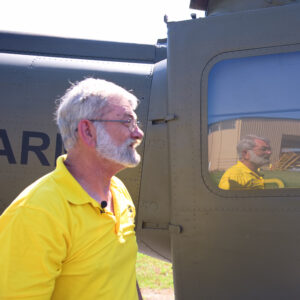
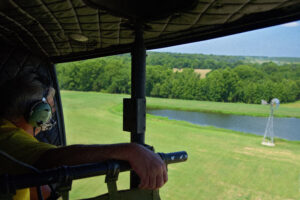
On Saturday, June 6th, 2020, David L. Riley and his wife Cheryl of Kokomo, Indiana, made their way to Mid America Flight Museum to rediscover what was for him, a long lost love. It had been almost 50 years since Riley had flown his last flight on one of his favorite helicopters from his time in Vietnam. All concerned and involved with this reunion looked on with great anticipation. While tempered with a few tears for us all, the smiles were unforgettable.
The Machine
67-17238, a Bell UH-1H Iroquois, U.S. Army Helicopter, was never meant for static display in some musty old museum nor was it meant to be scrapped for its metals. It was born in another era, another time, and for other tasks, halfway around the world. Today though, it nimbly darts above part of the “Green Carpet” Route Lady Byrd Johnson championed in 1965. The route sprang from an initiative to create a four-lane highway that stretched from the Red River north of Paris, Tx, and all the way south to Beaumont. At a stop off along the route, Mid America Flight Museum is now 238’s caretaker. 238’s mission today, is to uphold and honor the service and sacrifices of the veterans who fought beneath it, who fought alongside it, and, who fought from within it.
Just as it was over fifty years ago, 238’s rotor thumping a pulse of a little over 300 RPMs, telegraphs its approach with its uniquely familiar sound. 238 again carries her old war paint including her former call sign “Long Knife 21.” There are other markings signifying that this helicopter belonged to D Troop, 3rd/5th Cavalry. The unit was assigned to and would ultimately be the sole air support for the 9th Infantry Division in South Vietnam when her sister squadrons were moved farther north. Prompting the squadron to adopt the name “Bastard Cavalry” as was depicted on some of the aircraft.
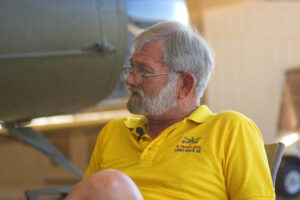
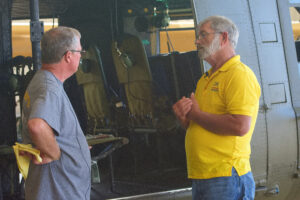
A book could be written about 238’s service, retirement, and resurrection but that’s a story for another day. With no disrespect to the old H model and her service, it’s more important today that we recognize the young Americans associated with the aircraft; veterans who served selflessly. In the late 1960s, the country’s official line was that they were being sent to thwart the expansion of Communism which perhaps was only partially true.
Once there, however; it’s a pretty safe bet if you were to ask those who were putting it all on the line what they were fighting for, they would likely tell you they were fighting for each other. “Just doing our job” would be how most would describe their service, then and now. Although some rivalries and contention may have existed among the ranks, in the end, they would be willing to lay down their lives for one another. Sadly, many did. Many made the ultimate sacrifice as part of just doing their job for indeed, they truly were brothers in arms.
After just doing their job, many returned to find an ungrateful country, a country that had called them up; given them a job to do which most did without equivocation. Their struggles had been as real and horrific as anything seen in previous world wars but there were no ticker-tape parades upon returning home. Many of these brave young men would not begin to receive due recognition for their honorable service until two generations or more had passed.
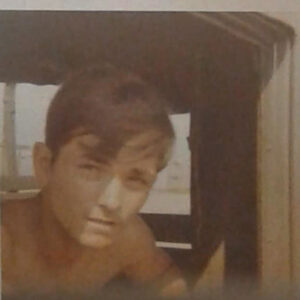
A very young David Riley upon arriving in Vietnam
The Man
19-year old David Riley was one of those who “just did his job”. Riley’s first appointment to hook up with 67-17238 was in January of 1970 when he arrived for what would be his first of two tours in Vietnam. His 10-month association with 238 would come to a tumultuous end. A lasting bond was formed between Riley and 238, his first and most favored aircraft during his service in Vietnam. He was 238’s sole Crew Chief for that time. Riley and 238 parted ways by the close of 1970. Amazingly today, Riley can still rattle off the numerous helicopter serial numbers he “crewed.” 67-17238 however, remained that special one, perhaps akin to the old adage of “The one that got away.”
(Below) Scott Glover and David Riley discussing Riley’s time with 238.
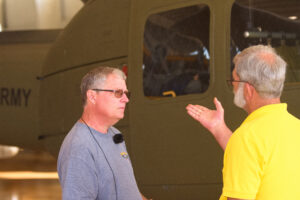
David Riley went on to serve as crew chief of other combat aircraft but he has always held a special feeling for this particular aircraft. He undoubtedly attributes having made it home at least in part to the rugged airworthiness of 238. While some did not get out alive, there are untold numbers of men who did return from just doing their job because of the bravery and skill of the pilots and crew of 238.
Where even leaving the field of battle was often hotly contested, it would be Riley’s face, with his hands on the aerial modified M-2 .50 cal machine gun, swinging out the open side door of 238, coaching soldiers aboard. Like a rearguard, he had their backs until they somehow made good their escape from a hot LZ. Only then might they reach the relative safety of hostile skies until they arrived at some base or staging area. Lift after lift, Riley and his crew flew into the fury and for the most part, flew out again.
238 also served in capacities other than as a lift shift. Like other lift ships, 238 and crew flew medevac in urgent situations and they could get to the wounded before the Dust Off (Medevac) guys could get there. Unique to 238 however; was her role as a Command and Control ship. 238 was one of two H Models that flew “C&C” for D Troop at the time.
As Crew Chief of 238, it had been Riley’s duty to provide day to day mechanical care and to prepare the aircraft for the next day’s mission. This included ensuring there was a full complement of ammunition. He basically took care of all maintenance that could be done in the field, short of having to take the bird into a maintenance facility for more major repairs. Also as Crew Chief, Riley held the customary position as “Door Gunner” a significantly important position that often resulted in extremely close relationships with the pilots.

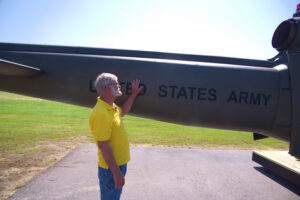
(Above) Riley told of the tail boom of 238 being shot off once near where he had his hand.
Further unique features of 238, was that it was fitted with a .50 caliber machine gun on the left side at Riley’s position. Like other “Slicks” as they were called, 238 also had an M-60 machine-gun manned by a door gunner on the rights side of the aircraft. Most lift ships had an M-60 on both sides but 238 who had a dual role as a C&C bird, had other duties that needed the significantly increased firepower of the M-2 .50 Caliber Machine-gun. This modification added significantly more range and firepower than the smaller round of the M-60.
“The floor (of the aircraft) was often covered with brass,” Riley said. A pair of Cobras would dive in with the second Cobra provided rear cover for the first as it was climbing out. “Our job was to cover the second Cobra’s climb out with the 50 Caliber,” Riley said. Cobra’s had several tactics where the lead ship once out of the immediate fray, might circle flanking the enemy as the second ship climbed out. Riley aboard 238, was tasked with covering the climb outs to the rear and below the Cobras.
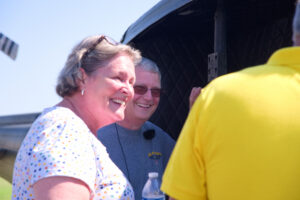
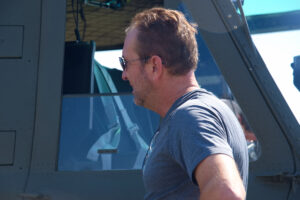
On a hot and humid Saturday, this June, Mid America Flight Museum Founder Scott Glover and David Riley sat down beside 238 with its forward blade angled forward and upward much like a soldier showing deference to the stars and stripes. The plan that day was to record an interview with Riley and later, have Riley once more take to the skies in 238. This was a highly anticipated reunion for both Riley and the MAMF Team.

We would learn from Riley that D Troop, 3rd/5th Cavalry consisted of the following aircraft:
- 9 OH-6As, aka “Loaches” Call signed War Wagon 10-19
- 9 UH-1Hs, aka “Slicks” Call signed Long Knife 20-29
- 9 AH-1Gs, aka “Cobras” Call signed Crusader 30-39
Riley had been shot down several times and Glover asked about those incidents. “The first time I was ever shot out of the sky with it, we went to the U Mihn Forest, a bad place.” “Charlie owned U Mihn Forrest, we didn’t,” Riley said. “We went in for the sole purpose of taking care of a division of the 9th Infantry to make sure that they got in and got back out.” “If needed, more got brought in and we would bring supplies. The jobs changed so much.”
“That Day, it was flying a lift mission, we were in Position Three “Tail gunner” We come in and it was a really small Landing Zone.” “And we were coming in and we had 10 ARVNs on board and they shot up one rotor blade so bad, the airplane went down before we got them off.” “They had shot the chin bubble out of it, the greenhouse out of it on the pilot’s side and one blade was shot up pretty bad.” “We hit the ground fairly hard.”Riley continued “we had to call in a Chinook, one of the boxcars to come and get it and take it back to Vihn Long” “That night the rotor blade was changed on it and the next day it was flyable again.”

“The second time I went down in it was near Cambodia it was such a hot LZ there were guns coming from every direction and we were right beside a tree line about 30 feet off the ground.” “We were flying about 80 knots and it hit the ground pretty hard and the fire warning lights came on and it was a big no-no for us.” “It was not on fire but the fuel cells had been hit and we had to redo that.” “Again a Lift ship was called in to sling it back.” “It took 20 to 30 minutes for a Chinook to arrive and you had to fight as you were preparing to sling the helicopter.”
Gazing at the side of the aircraft, Riley continued to reminisce… “We had our own Infantry called ‘Blues’ we would bring in our own people to guard the aircraft.” “Two guys would sling the aircraft and they handed me the donut and when the Chinook come in so I could hook into his hook.” “Then I could ONE climb up or Climb off.” “I always chose to climb up.” “I wanted to go back with the Bird.” “I’m using the straps to climb up because there is an opening in the floor that you could get into.”
Riley continued “For most of the crew chiefs we wanted to go back with the aircraft because it was our aircraft, we wanted it done right, and we didn’t want anybody punching it off.” “I’ve had them punched off before, even here in the United States.” “Once one gets punched off, there is not much left of it.” “I had a Mike Model punched off into the Potomac by a Marine Chinook.”
Then came Riley’s final flight on 238, or so he believed. “It was in September of 1970.” “We took 37 rounds in it and an RPG in the tail boom and it laid on its side.” With melancholy, Riley recounted that he too had been hit by bullets and shrapnel. “They never did get it all out,” said Riley.
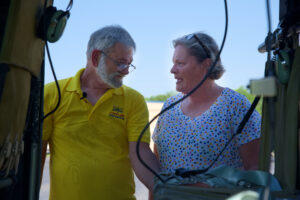
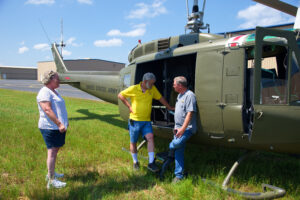
Riley told of being taken to a 3rd Surgical Hospital in Bihn Tuy, where he would spend about one month recovering from his injuries. The hospital stay overlapped with Riley’s scheduled R&R and he lost track of time, learning later that he was short and due to return to the States.
After 238 had been taken offline, Riley said Riley hunted down the helicopter up and retrieved the nose panel with the distinctive Long Knife 21 logo that had been painted on it over about a one week period by Riley, Frank Martinez, and Charles Slayton. “We were flying every day then,” said Riley. “I took it and put it on the nose of 405” (67-17405) the next airship to assume the role as Long Knife 21 which was then being crewed by Crew Chief Claude Stevens. Riley would go on to next be the Crew Chief of 084. In a moment of reflection, Riley said “Our job was go out and start a fight” and that’s what they did.
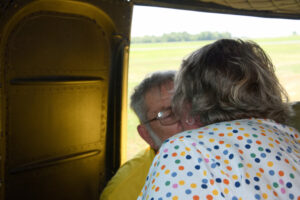
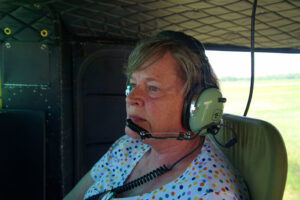
After convalescing from his injuries sustained on his last flight on 238, Riley signed up for his second tour and relieved special training for his return to Vietnam when he was to crew the latest model Huey, the UH-1M or “Mike” models as they were called. As Crew Chief in the “Mike Models,” Riley participated in the Lam Son 719 Operation, hunting down and taking out anti-aircraft guns. During the operation, the U.S. Military lost several hundred aircraft.
Glover asked Riley of the three times 238 went down, and if everyone got out and Riley said “No, that’s what really hurts.” David Riley carries with him a list of names not just on paper, but in his heart. Names of those he served with who didn’t make it back alive. For the few of us on hand for the interview, I don’t think there was a dry eye among us, as David Riley slipped his hand slowly across some patched bullet holes in the floor, just inside the door opening on the right side.
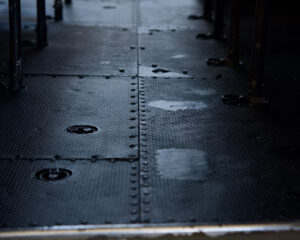
One of Riley’s many tasks had been to repair 238’s battle damage.
Changing the tone of the interview, Glover suggested that Riley fulfill his most recent mission to gain fly in his beloved 67-17238. For this flight, 238 would no longer draw enemy gunfire, only wowed looks from those looking on from below as David Riley kept his appointment to reunite with 238. Riley and his wife Cheryl had invested a trip to Olympia, Washington to first see it, then again from Indiana to Texas where he encountered his first opportunity for the reunion flight.
Scott Urschel making last-minute adjustments to on-board video cameras
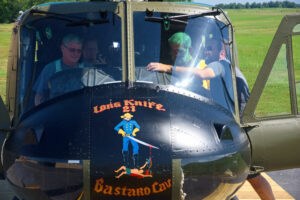
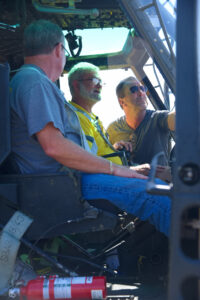
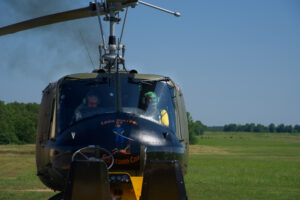
I was particularly moved with emotion, to look on as 238 lifted off from the ground in Texas with David L. Riley, seated in the left seat. It had been over 50 years in coming, the reunion.
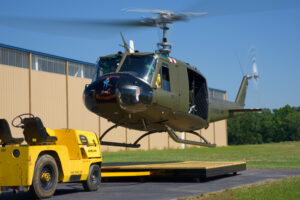
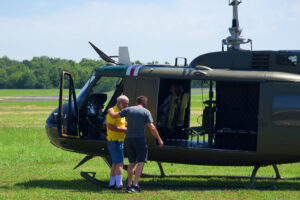
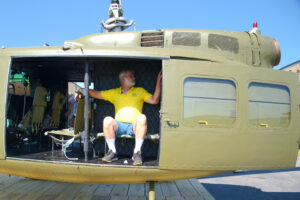
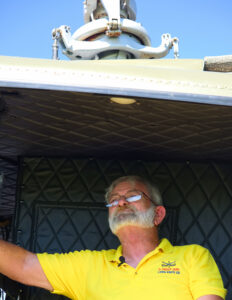
With great privilege, I was asked to ride along and take a few photos of Riley flying in the left door gunner’s well of his beloved 238. It was both surreal and humbling to be on hand to witness the moment. To witness Riley gazing over the greenery of the Northeast Texas countryside was an experience that is difficult to put into words.
David Riley would return to Vietnam for his second tour where he was assigned to Mike Model Gunships. Flying in that configuration, he was equipped with a bungee slung M-60. We asked Riley if he missed the big .50 Caliber and he replied “No, not really.” He then sent an example picture of a Mike Model fitted with rocket launchers and Gatlin style “Mini-Guns” on each side. Today, David Riley remains active with other members of Lighthorse, D Troop, 3rd/5th Cavalry Reunions. In a short time, we have gotten to know David and Cheryl, we count them as dear friends.

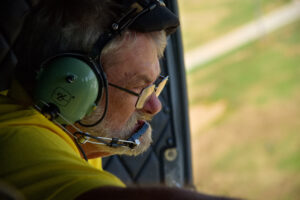
Michael Ryerson once wrote a profoundly moving poem for a friend of his who had been a door gunner in Vietnam titled “The Man in The Doorway.” Ryerson’s poem echoed in my mind throughout the interview and flight with David Riley. While he was just one of many, to us, he was that “Man in the Doorway.”
(Below) Riley onboard 238 for a spectacular Texas sunset ride and is joined by U.S. Army (Ret) Vietnam Veteran, CWO, Gary Gingrich. Gary is a cherished member of Mid America Flight Museum.
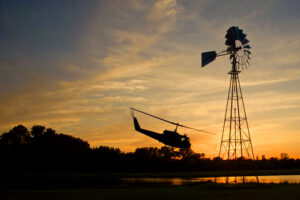
Special thanks to Scott Urschel as well as the rest of the Mid America Flight Museum Team who continuously work so hard to make things like this special reunion happen.
Article by W.P. Minor, 2020
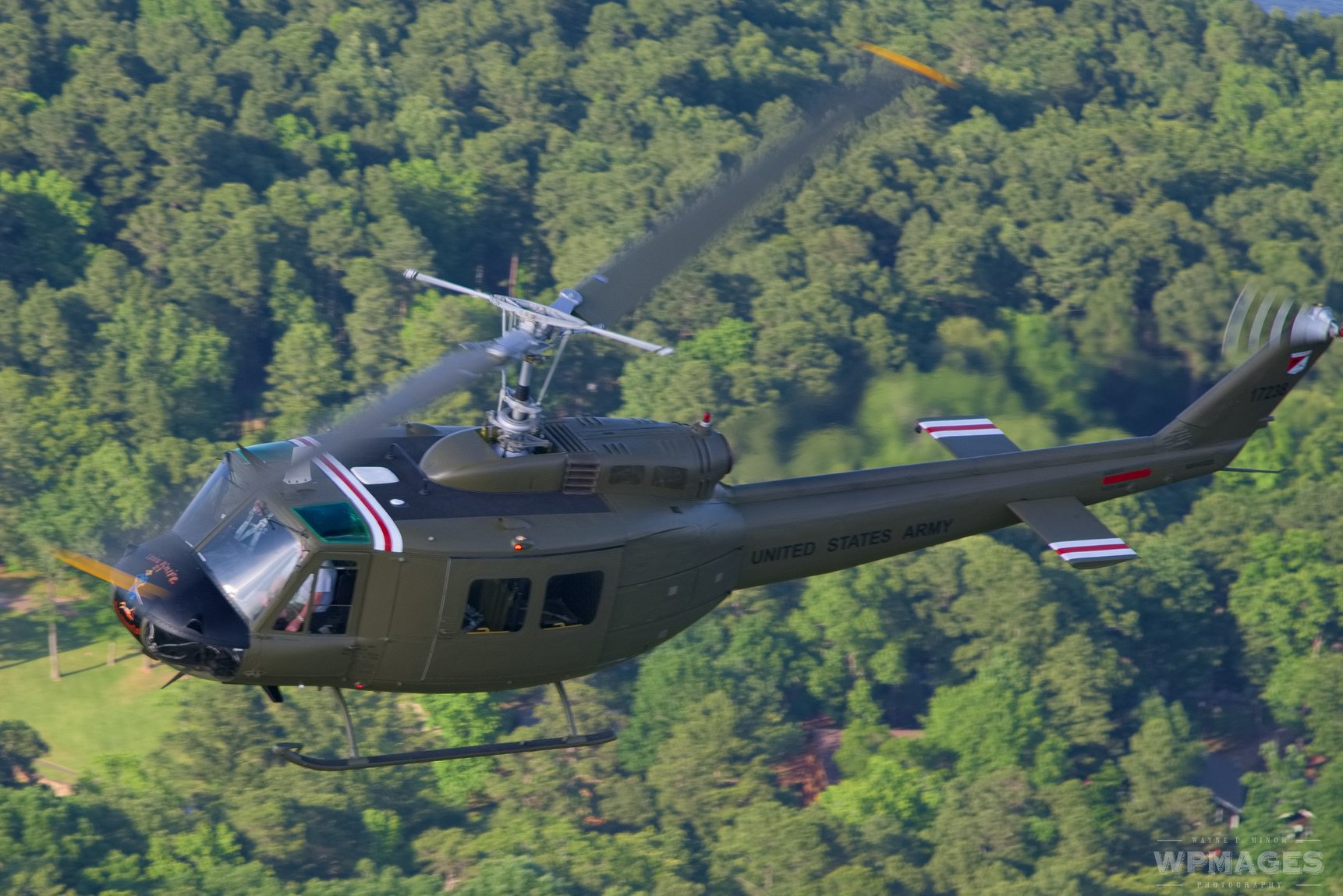
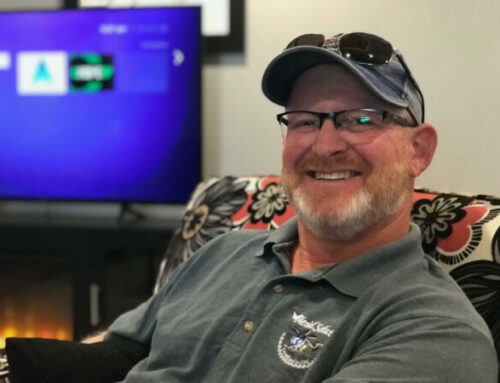
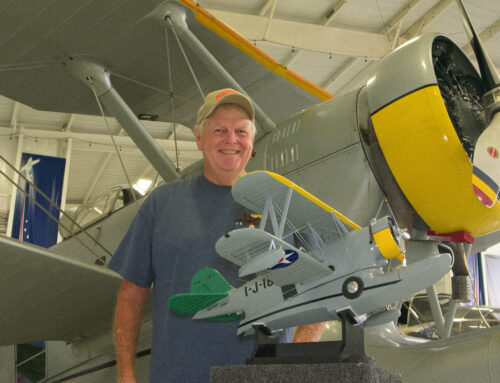
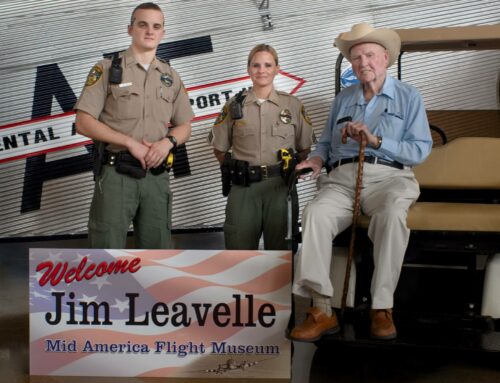
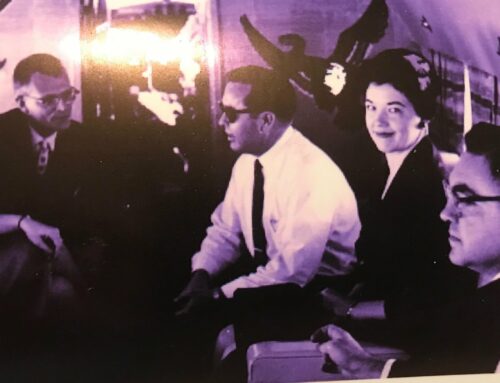
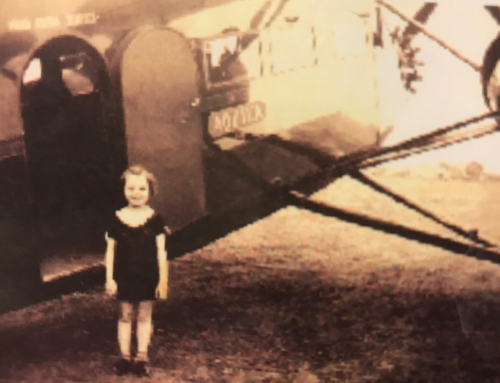
Leave A Comment